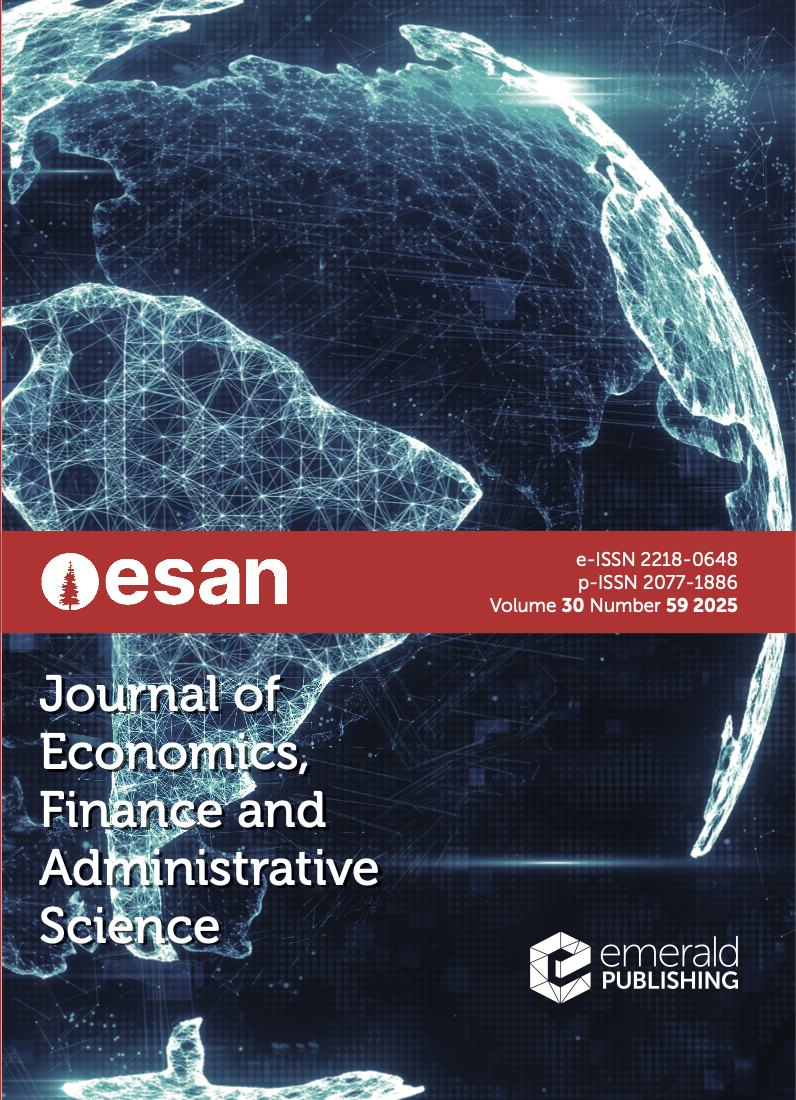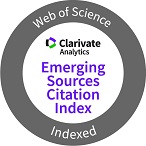Does trading mechanism shape cross-market integration? Evidence from stocks and corporate bonds on the Tel Aviv Stock Exchange
Keywords:
Corporate bonds, Stocks, Cross-market integration, Trading mechanism, Conditional volatilityAbstract
PurposeThis study investigates the influence of trading mechanisms on cross-market integration between stocks and corporate bonds on the Tel Aviv Stock Exchange (TASE) during the COVID-19 crisis. Unlike the worldwide practice of trading corporate bonds on an over-the-counter (OTC) market, TASE uses a limit-order-book (LOB) for both stocks and bonds, potentially creating unique volatility dynamics through direct information spillover. We analyze the volatility dynamics and spillover effects between TASE’s stock and corporate bond markets.
Design/methodology/approachWe employ an exponential general autoregressive conditional heteroskedastic (EGARCH)(1,1) model to assess the impact of stock market fear, measured by implied volatility, on Tel-Bond 20 Index returns and volatility. A bivariate diagonal Baba-Engle-Kraft-Kroner (BEKK) model is also applied to capture time-series integration and cross-volatility spillovers between the TA-35 Index (stocks) and the Tel-Bond 20 Index (corporate bonds), especially during financial stress.
FindingsThe EGARCH model reveals a significant contagion effect, with increased stock market fear lowering corporate bond returns and increasing bond volatility. It also indicates a leverage effect, where negative shocks disproportionately amplify bond volatility. Diagonal BEKK results confirm strong cross-market volatility persistence, especially during crises, highlighting substantial financial contagion between stocks and bonds in TASE. While TASE’s market design improves the overall market quality, these findings underscore the LOB trading mechanism in facilitating financial contagion and systemic risk.
Practical implicationsThe LOB trading in TASE facilitates direct information flow, intensifying volatility spillover and cross-market integration, with the degree of integration fluctuating based on market conditions. Investors and managers should consider alternative hedging strategies during volatile periods, as stock market sentiment significantly impacts bond stability. Regulators should assess how trading mechanisms affect market integration and risk, especially during periods of distress.
Originality/valueThis study offers new insights into how trading mechanisms influence cross-market dynamics, contributing to the literature on market design and financial contagion.
Downloads
References
Abraham, F., Cortina, J.J. and Schmukler, S.L. (2021), “The rise of domestic capital markets for corporate financing: lessons from East Asia”, Journal of Banking and Finance, Vol. 122, 105987, doi: 10.1016/j.jbankfin.2020.105987.
Abudy, M.(M.) and Shust, E. (2023), “Does market design contribute to market stability? Indications from a corporate bond exchange during the COVID-19 crisis”, Journal of Economics and Business, Vol. 123, 106105, doi: 10.1016/j.jeconbus.2022.106105.
Abudy, M. and Wohl, A. (2018), “Corporate bond trading on a limit order book exchange”, Review of Finance, Vol. 22 No. 4, pp. 1413-1440, doi: 10.1093/rof/rfx054.
Abudy, M.M., Nathan, D. and Wohl, A. (2024), “Mutual fund flows and government bond returns”, Journal of Banking and Finance, Vol. 162, 107119, doi: 10.1016/j.jbankfin.2024.107119.
Acharya, V.V. and Pedersen, L.H. (2005), “Asset pricing with liquidity risk”, Journal of Financial Economics, Vol. 77 No. 2, pp. 375-410, doi: 10.1016/j.jfineco.2004.06.007.
Acharya, V.V., Amihud, Y. and Bharath, S.T. (2013), “Liquidity risk of corporate bond returns: conditional approach”, Journal of Financial Economics, Vol. 110 No. 2, pp. 358-386, doi: 10.1016/j.jfineco.2013.08.002.
Allen, D.E. and McAleer, M. (2018), “Theoretical and empirical differences between diagonal and full BEKK for risk management”, Energies, Vol. 11 No. 7, 1627, doi: 10.3390/en11071627.
Anginer, D. and Yildizhan, Ç. (2018), “Is there a distress risk anomaly? Pricing of systematic default risk in the cross-section of equity returns”, Review of Finance, Vol. 22 No. 2, pp. 633-660, doi: 10.1093/rof/rfx044.
Aslanidis, N., Christiansen, C. and Savva, C.S. (2020), “Flight-to-safety and the risk-return trade-off: European evidence”, Finance Research Letters, Vol. 35, 101294, doi: 10.1016/j.frl.2019.09.009.
Baele, L., Bekaert, G., Inghelbrecht, K. and Wei, M. (2020), “Flights to safety”, Review of Financial Studies, Vol. 33 No. 2, pp. 689-746, doi: 10.1093/rfs/hhz055.
Bai, J., Bali, T.G. and Wen, Q. (2019), “Common risk factors in the cross-section of corporate bond returns”, Journal of Financial Economics, Vol. 131 No. 3, pp. 619-642, doi: 10.1016/j.jfineco.2018.08.002.
Bajo, E., Barbi, M., Bigelli, M. and Hillier, D. (2013), “The role of institutional investors in public-to-private transactions”, Journal of Banking and Finance, Vol. 37 No. 11, pp. 4327-4336, doi: 10.1016/j.jbankfin.2013.07.004.
Baker, M. and Stein, J.C. (2004), “Market liquidity as a sentiment indicator”, Journal of Financial Markets, Vol. 7 No. 3, pp. 271-299, doi: 10.1016/j.finmar.2003.11.005.
Baker, M. and Wurgler, J. (2006), “Investor sentiment and the cross-section of stock returns”, The Journal of Finance, Vol. 61 No. 4, pp. 1645-1680, doi: 10.1111/j.1540-6261.2006.00885.x.
Baker, M. and Wurgler, J. (2007), “Investor sentiment in the stock market”, The Journal of Economic Perspectives, Vol. 21 No. 2, pp. 129-151, doi: 10.1257/jep.21.2.129.
Bali, T.G., Subrahmanyam, A. and Wen, Q. (2021), “The macroeconomic uncertainty premium in the corporate bond market”, Journal of Financial and Quantitative Analysis, Vol. 56 No. 5, pp. 1653-1678, doi: 10.1017/S0022109020000538.
Barber, B.M. and Odean, T. (2008), “All that glitters: the effect of attention and news on the buying behavior of individual and institutional investors”, Review of Financial Studies, Vol. 21 No. 2, pp. 785-818, doi: 10.1093/rfs/hhm079.
Barberis, N., Shleifer, A. and Vishny, R. (1998), “A model of investor sentiment”, Journal of Financial Economics, Vol. 49 No. 3, pp. 307-343, doi: 10.1016/s0304-405x(98)00027-0.
Batten, J.A., Khaw, K.L.H. and Young, M.R. (2018), “Pricing convertible bonds”, Journal of Banking and Finance, Vol. 92, pp. 216-236, doi: 10.1016/j.jbankfin.2018.05.006.
Baur, D. and Lucey, B. (2009), “Flights and contagion-An empirical analysis of stock-bond correlations”, Journal of Financial Stability, Vol. 5 No. 4, pp. 339-352, doi: 10.1016/j.jfs.2008.08.001.
Bernanke, B.S. and Kuttner, K.N. (2005), “What explains the stock market's reaction to federal reserve policy?”, The Journal of Finance, Vol. 60 No. 3, pp. 1221-1257, doi: 10.1111/j.1540-6261.2005.00760.x.
Bethke, S., Gehde-Trapp, M. and Kempf, A. (2017), “Investor sentiment, flight-to-quality, and corporate bond comovement”, Journal of Banking and Finance, Vol. 82, pp. 112-132, doi: 10.1016/j.jbankfin.2017.02.007.
Bollerslev, T. (1990), “Modelling the coherence in short-run nominal exchange rates: a multivariate generalized arch model”, The Review of Economics and Statistics, Vol. 72 No. 3, p. 498, doi: 10.2307/2109358.
Boulatov, A., Hendershott, T. and Livdan, D. (2013), “Informed trading and portfolio returns”, The Review of Economic Studies, Vol. 80 No. 1, pp. 35-72, doi: 10.1093/restud/rds020.
Boyd, J.H., Hu, J. and Jagannathan, R. (2005), “The stock market's reaction to unemployment news: why bad news Is usually good for stocks”, The Journal of Finance, Vol. 60 No. 2, pp. 649-672, doi: 10.1111/j.1540-6261.2005.00742.x.
Brown, G.W. and Cliff, M.T. (2004), “Investor sentiment and the near-term stock market”, Journal of Empirical Finance, Vol. 11 No. 1, pp. 1-27, doi: 10.1016/j.jempfin.2002.12.001.
Campbell, J.Y., Pflueger, C. and Viceira, L.M. (2020), “Macroeconomic drivers of bond and equity risks”, Journal of Political Economy, Vol. 128 No. 8, pp. 3148-3185, doi: 10.1086/707766.
Cappiello, L., Engle, R.F. and Sheppard, K. (2006), “Asymmetric dynamics in the correlations of global equity and bond returns”, Journal of Financial Econometrics, Vol. 4 No. 4, pp. 537-572, doi: 10.1093/jjfinec/nbl005.
Chang, C.L. and McAleer, M. (2017), “The correct regularity condition and interpretation of asymmetry in EGARCH”, Economics Letters, Vol. 161, pp. 52-55, doi: 10.1016/j.econlet.2017.09.017.
Chen, L., Lesmond, D.A. and Wei, J. (2007), “Corporate yield spreads and bond liquidity”, The Journal of Finance, Vol. 62 No. 1, pp. 119-149, doi: 10.1111/j.1540-6261.2007.01203.x.
Choi, J. and Kim, Y. (2018), “Anomalies and market (dis)integration”, Journal of Monetary Economics, Vol. 100, pp. 16-34, doi: 10.1016/J.JMONECO.2018.06.003.
Chordia, T., Goyal, A., Nozawa, Y., Subrahmanyam, A. and Tong, Q. (2017), “Are capital market anomalies common to equity and corporate bond markets? An empirical investigation”, Journal of Financial and Quantitative Analysis, Vol. 52 No. 4, pp. 1301-1342, doi: 10.1017/S0022109017000515.
Chung, K.H., Wang, J. and Wu, C. (2019), “Volatility and the cross-section of corporate bond returns”, Journal of Financial Economics, Vol. 133 No. 2, pp. 397-417, doi: 10.1016/j.jfineco.2019.02.002.
Connolly, R., Stivers, C. and Sun, L. (2005), “Stock market uncertainty and the stock-bond return relation”, Journal of Financial and Quantitative Analysis, Vol. 40 No. 1, pp. 161-194, doi: 10.1017/s0022109000001782.
Cronin, D., Flavin, T.J. and Sheenan, L. (2016), “Contagion in Eurozone sovereign bond markets? The good, the bad and the ugly”, Economics Letters, Vol. 143, pp. 5-8, doi: 10.1016/j.econlet.2016.02.031.
Dick-Nielsen, J., Feldhütter, P. and Lando, D. (2012), “Corporate bond liquidity before and after the onset of the subprime crisis”, Journal of Financial Economics, Vol. 103 No. 3, pp. 471-492, doi: 10.1016/j.jfineco.2011.10.009.
Dickey, D.A. and Fuller, W.A. (1981), “Likelihood ratio statistics for autoregressive time series with a unit root”, Econometrica, Vol. 49 No. 4, p. 1057, doi: 10.2307/1912517.
Downing, C., Underwood, S. and Xing, Y. (2009), “The relative informational efficiency of stocks and bonds: an intraday analysis”, Journal of Financial and Quantitative Analysis, Vol. 44 No. 5, pp. 1081-1102, doi: 10.1017/S0022109009990305.
Edwards, A.K., Harris, L.E. and Piwowar, M.S. (2007), “Corporate bond market transaction costs and transparency”, The Journal of Finance, Vol. 62 No. 3, pp. 1421-1451, doi: 10.1111/j.1540-6261.2007.01240.x.
Engle, R.F. (2002), “Dynamic conditional correlation: a simple class of multivariate generalized autoregressive conditional heteroskedasticity models”, Journal of Business and Economic Statistics, Vol. 20 No. 3, pp. 339-350, doi: 10.1198/073500102288618487.
Engle, R.F. and Kroner, K.F. (1995), “Multivariate simultaneous generalized arch”, Econometric Theory, Vol. 11 No. 1, pp. 122-150, doi: 10.1017/S0266466600009063.
Fengler, M.R., Herwartz, H. and Raters, F.H.C. (2017), pp. “25-37, Multivariate volatility models”, doi: 10.1007/978-3-662-54486-0_2.
Forbes, K. and Rigobon, R. (2002a), “Measuring stock market comovements”, The Journal of Finance, Vol. 57 No. 5, pp. 2223-2261, doi: 10.1111/0022-1082.00494.
Forbes, K. and Rigobon, R. (2002b), “No contagion, only interdependence: measuring stock market comovements”, The Journal of Finance, Vol. 57 No. 5, pp. 2223-2261, doi: 10.1111/0022-1082.00494.
Friewald, N., Jankowitsch, R. and Subrahmanyam, M.G. (2012), “Illiquidity or credit deterioration: a study of liquidity in the US corporate bond market during financial crises”, Journal of Financial Economics, Vol. 105 No. 1, pp. 18-36, doi: 10.1016/j.jfineco.2012.02.001.
Gebhardt, W.R., Hvidkjaer, S. and Swaminathan, B. (2005), “Stock and bond market interaction: does momentum spill over?”, Journal of Financial Economics, Vol. 75 No. 3, pp. 651-690, doi: 10.1016/j.jfineco.2004.03.005.
Glosten, L.R., Jagannathan, R. and Runkle, D.E. (1993), “On the relation between the expected value and the volatility of the nominal excess return on stocks”, The Journal of Finance, Vol. 48 No. 5, pp. 1779-1801, doi: 10.1111/j.1540-6261.1993.tb05128.x.
Goldstein, M.A. and Namin, E.S. (2023), “Corporate bond liquidity and yield spreads: a review”, Research in International Business and Finance, Vol. 65, 101925, doi: 10.1016/j.ribaf.2023.101925.
Graham, J.R., Leary, M.T. and Roberts, M.R. (2015), “A century of capital structure: the leveraging of corporate America”, Journal of Financial Economics, Vol. 118 No. 3, pp. 658-683, doi: 10.1016/J.JFINECO.2014.08.005.
Gur-Gershgoren, G., Kedar-Levy, H. and Hadad, E. (2020), “Deep-market by IAS-19: a unified cross-country approach for discount rate selection*”, Multinational Finance Journal, Vol. 24, pp. 3-4.
Gurun, U.G., Johnston, R. and Markov, S. (2016), “Sell-side debt analysts and debt market efficiency”, Management Science, Vol. 62 No. 3, pp. 682-703, doi: 10.1287/mnsc.2014.2145.
Hadad, E. and Kedar-Levy, H. (2024), “The impact of retail investor sentiment on the conditional volatility of stocks and bonds: evidence from the Tel-Aviv stock exchange”, International Review of Economics and Finance, Vol. 89, pp. 1303-1313, doi: 10.1016/J.IREF.2023.09.002.
Haesen, D., Houweling, P. and van Zundert, J. (2017), “Momentum spillover from stocks to corporate bonds”, Journal of Banking and Finance, Vol. 79, pp. 28-41, doi: 10.1016/j.jbankfin.2017.03.003.
Hendershott, T., Livdan, D. and Schürhoff, N. (2015), “Are institutions informed about news?”, Journal of Financial Economics, Vol. 117 No. 2, pp. 249-287, doi: 10.1016/j.jfineco.2015.03.007.
Hong, H. and Stein, J.C. (1999), “A unified theory of underreaction, momentum trading, and overreaction in asset markets”, The Journal of Finance, Vol. 54 No. 6, pp. 2143-2184, doi: 10.1111/0022-1082.00184.
Hong, Y., Lin, H. and Wu, C. (2012), “Are corporate bond market returns predictable?”, Journal of Banking and Finance, Vol. 36 No. 8, pp. 2216-2232, doi: 10.1016/j.jbankfin.2012.04.001.
Huang, H.H., Huang, H.Y. and Oxman, J.J. (2015), “Stock liquidity and corporate bond yield spreads: theory and evidence”, Journal of Financial Research, Vol. 38 No. 1, pp. 59-91, doi: 10.1111/jfir.12052.
Kaniel, R., Saar, G. and Titman, S. (2008), “Individual investor trading and stock returns”, The Journal of Finance, Vol. 63 No. 1, pp. 273-310, doi: 10.1111/j.1540-6261.2008.01316.x.
Katsiampa, P., Yarovaya, L. and Zięba, D. (2022), “High-frequency connectedness between Bitcoin and other top-traded crypto assets during the COVID-19 crisis”, Journal of International Financial Markets, Institutions and Money, Vol. 79, 101578, doi: 10.1016/j.intfin.2022.101578.
Khalid, A. and Ahmad, Z. (2023), “Stock--bond co-movement in ASEAN-5: the role of financial integration and financial development”, International Journal of Emerging Markets, Vol. 18 No. 5, pp. 1033-1052, doi: 10.1108/ijoem-11-2020-1312.
Kumar, A. and Lee, C.M.C. (2006), “Retail investor sentiment and return comovements”, The Journal of Finance, Vol. 61 No. 5, pp. 2451-2486, doi: 10.1111/j.1540-6261.2006.01063.x.
Leschinski, C. and Bertram, P. (2017), “Time varying contagion in EMU government bond spreads”, Journal of Financial Stability, Vol. 29, pp. 72-91, doi: 10.1016/j.jfs.2017.01.007.
Li, P., Guo, Y. and Meng, H. (2022), “The default contagion of contingent convertible bonds in financial network”, The North American Journal of Economics and Finance, Vol. 60, 101661, doi: 10.1016/j.najef.2022.101661.
Lithin, B.M., Chakraborty, S., Iyer, V., Nikhil, M.N. and Ledwani, S. (2023), “Modelling asymmetric sovereign bond yield volatility with univariate GARCH models: evidence from India”, Cogent Economics and Finance, Vol. 11 No. 1, doi: 10.1080/23322039.2023.2189589.
Longstaff, F.A. (2004), “The flight-to-liquidity premium in U.S. treasury bond prices”, Journal of Business, Vol. 77 No. 3, pp. 511-526, doi: 10.1086/386528.
Lu, C.W., Chen, T.K. and Liao, H.H. (2010), “Information uncertainty, information asymmetry and corporate bond yield spreads”, Journal of Banking and Finance, Vol. 34 No. 9, pp. 2265-2279, doi: 10.1016/j.jbankfin.2010.02.013.
McAleer, M. (2019), “What they did not tell you about algebraic (non-) existence, mathematical (IR-)regularity, and (non-) asymptotic properties of the dynamic conditional correlation (DCC) model”, Journal of Risk and Financial Management, Vol. 12 No. 2, p. 61, doi: 10.3390/jrfm12020061.
Merton, R.C. (1974), “ON the pricing of corporate debt: the risk structure of interest rates*”, The Journal of Finance, Vol. 29 No. 2, pp. 449-470, doi: 10.1111/j.1540-6261.1974.tb03058.x.
Morana, C. and Beltratti, A. (2008), “Comovements in international stock markets”, Journal of International Financial Markets, Institutions and Money, Vol. 18 No. 1, pp. 31-45, doi: 10.1016/j.intfin.2006.05.001.
Mukherjee, K.nath (2019), “Demystifying yield spread on corporate bonds trades in India”, Asia-Pacific Financial Markets, Vol. 26 No. 2, pp. 253-284, doi: 10.1007/s10690-018-09266-w.
Næs, R., Skjeltorp, J.A. and Ødegaard, B.A. (2011), “Stock market liquidity and the business cycle”, The Journal of Finance, Vol. 66 No. 1, pp. 139-176, doi: 10.1111/j.1540-6261.2010.01628.x.
Nayak, S. (2010), “Investor sentiment and corporate bond yield spreads”, Review of Behavioral Finance, Vol. 2 No. 2, pp. 59-80, doi: 10.1108/19405979201000004.
Nelson, D.B. (1991), “Conditional heteroskedasticity in asset returns: a new approach”, Econometrica, Vol. 59 No. 2, p. 347, doi: 10.2307/2938260.
Nguyen, T.N., Phan, T.K.H. and Nguyen, T.L. (2022), “Financial contagion during global financial crisis and COVID–19 pandemic: the evidence from DCC–GARCH model”, Cogent Economics and Finance, Vol. 10 No. 1, doi: 10.1080/23322039.2022.2051824.
Opitz, S. and Szimayer, A. (2018), “What drives flight to quality?”, Accounting and Finance, Vol. 58 No. S1, pp. 529-571, doi: 10.1111/acfi.12315.
Pástor, Ľ. and Stambaugh, R.F. (2003), “Liquidity risk and expected stock returns”, Journal of Political Economy, Vol. 111 No. 3, pp. 642-685, doi: 10.1086/374184.
Patel, R., Goodell, J.W., Oriani, M.E., Paltrinieri, A. and Yarovaya, L. (2022), “A bibliometric review of financial market integration literature”, International Review of Financial Analysis, Vol. 80, 102035, doi: 10.1016/j.irfa.2022.102035.
Perron, P. (1988), “Trends and random walks in macroeconomic time series. Further evidence from a new approach”, Journal of Economic Dynamics and Control, Vol. 12, pp. 2-3, doi: 10.1016/0165-1889(88)90043-7.
Piazzesi, M. (2005), “Bond yields and the federal reserve”, Journal of Political Economy, Vol. 113 No. 2, pp. 311-344, doi: 10.1086/427466.
Piñeiro-Chousa, J., Vizcaíno-González, M. and Pérez-Pico, A.M. (2017), “Influence of social media over the stock market”, Psychology and Marketing, Vol. 34 No. 1, pp. 101-108, doi: 10.1002/mar.20976.
Ponrajah, J. and Ning, C. (2023), “Stock–bond dependence and flight to/from quality”, International Review of Financial Analysis, Vol. 86, 102467, doi: 10.1016/j.irfa.2022.102467.
Radi, S., Gebka, B. and Kallinterakis, V. (2024), “The wisdom of the madness of crowds: investor herding, anti-herding, and stock-bond return correlation”, Journal of Economic Behavior and Organization, Vol. 224, pp. 966-995, doi: 10.1016/j.jebo.2024.07.005.
Rath, P.K. (2023), “Nexus between Indian financial markets and macro-economic shocks: a VAR approach”, Asia-Pacific Financial Markets, Vol. 30 No. 1, pp. 131-164, doi: 10.1007/s10690-022-09372-w.
Tachibana, M. (2020), “Flight-to-quality in the stock–bond return relation: a regime-switching copula approach”, Financial Markets and Portfolio Management, Vol. 34 No. 4, pp. 429-470, doi: 10.1007/s11408-020-00361-5.
TASE (2021), “2021 annual report”, available at: https://info.tase.co.il/Eng/Lists/gen_res/0133_annual_review/2021__annualreview_eng.pdf
van Zundert, J. and Driessen, J. (2022), “Stocks versus corporate bonds: a cross-sectional puzzle”, Journal of Banking and Finance, Vol. 137, 106447, North-Holland, doi: 10.1016/J.JBANKFIN.2022.106447.
Whaley, R.E. (2000), “The investor fear gauge”, Journal of Portfolio Management, Vol. 26 No. 3, pp. 12-17, doi: 10.3905/jpm.2000.319728.
Wu, B., Min, F. and Wen, F. (2023), “The stress contagion among financial markets and its determinants”, The European Journal of Finance, Vol. 29 No. 11, pp. 1267-1302, doi: 10.1080/1351847X.2022.2111222.
Yang, J., Zhou, Y. and Wang, Z. (2009), “The stock-bond correlation and macroeconomic conditions: one and a half centuries of evidence”, Journal of Banking and Finance, Vol. 33 No. 4, pp. 670-680, doi: 10.1016/j.jbankfin.2008.11.010.
Zakoian, J.-M. (1994), “Threshold heteroskedastic models”, Journal of Economic Dynamics and Control, Vol. 18 No. 5, pp. 931-955, Elsevier, doi: 10.1016/0165-1889(94)90039-6.











